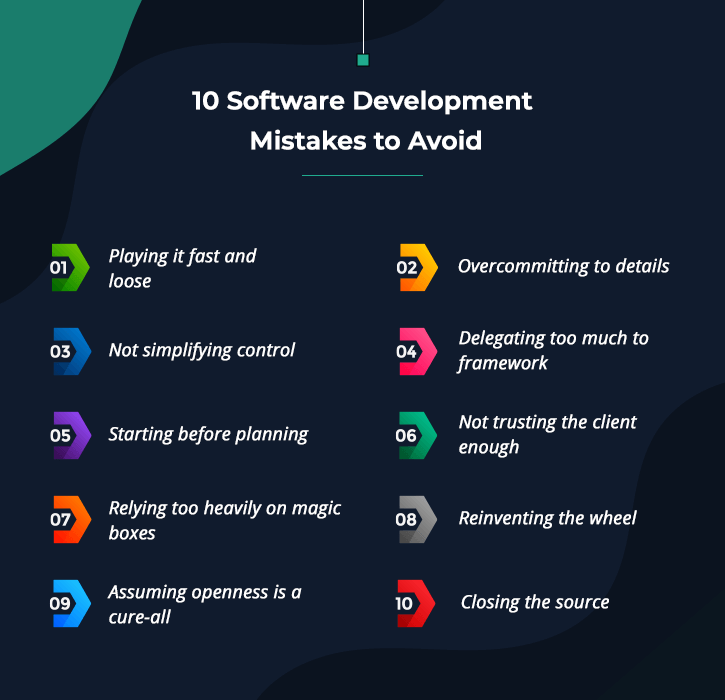From the simple software that came in CDs in the earlier days to the full cloud-based applications, the software development field has gone through major changes. With the increasing population of Internet users worldwide, it has become necessary for businesses to have their presence in the digital world. Similarly, when it comes to making the day to day working of an organisation more efficient, software plays a critical role. From accounting to human resource management, there is no field that is not touched by softwares. As a business grows its needs become more unique and thus it requires custom programs that are designed specifically.
But creating software is a complex process and it needs to be carried with utmost attention to precision and detail. Simple bugs in a program can evolve into a large problem if due care is not taken at the right time. The software can be standalone, web-based or for mobile usage, however, the need for the right process and systems remains at the core. As Bill Gates once said – “Software is a great combination between artistry and engineering”.
Developing software involves various factors such as complexity, cost, time available and the customisation it needs. Making a perfect balance between all these and delivering the right program is what software development is all about. However, there are some common mistakes in software development that usually result in unnecessary expenditure of both time and financial resources. Here in this blog, we explain the software development life cycle and the common mistakes that are committed in the process so that they can be avoided.
The Software Development Life Cycle
Developing software requires a proper plan and delegation of duties in case it is a large project. The software development life cycle or SDLC as it is popularly called is the complete roadmap used by a developer to build software from start to end including its deployment. The software development life cycle phases can be bifurcated into
1. Initial Requirement Research
Testing the plausibility of the ideas before going for development is a crucial step to avoid getting stuck. In the first phase, the developers and idea floaters meet and reach a consensus regarding the features and functionality of the program. This also includes brainstorming with the industry experts concerning the current market trends and requirements.
At the same time deciding on the cost factors is also an important consideration in the software development life cycle. Here the developers and the client discuss the cost implications of various technologies and features. At the end of this phase, the planning stage is initiated which includes choosing the development models.
2. Planning the Process
While the research stage is complete, the next step is planning where the delegation of the duties is conducted by the development team. The software can vary on various metrics such as the front end and backend and that is why features must be in line with the skills available with the developers. Also, the working model of the software development life cycle needs to be decided in this stage.
3. Designing the Architecture
The architecture of a program is the structure that defines the relationship between different elements. This includes
- Quality Attributes
- Design Environment
- Business Strategy
- Human Dynamics
- IT Environment
While the plan is a rough caricature of how things are to be carried out, the architecture is a solid base for all the actions that are to be taken and can play an important role in avoiding software developer common mistakes. This blueprint helps to set expectations with regards to the customer, marketing and management.
4. Development Process
The development phase is the actual stage where all the plans are executed as per their resource requirements. The development phase requires intense unit testing at every stage to ensure that any mistake or bug is caught at the beginning itself. Additionally, utmost attention is paid to communication between the various departments of the software development team as well as the stakeholders.
5. Testing the Product
After the completion of the development stage, the testing of the end product is done. Among which load testing is one of the most important tests that need to be carried out. Under this, the software is put under various artificial stress situations to ensure that it works seamlessly in case of load on the servers or in case of excess traffic.
6. Deployment
After the end of the development and testing phase, the deployment phase is intended to get the end product to its user. This also includes the availability of timely updates to the software. Today the software can be deployed in live environments thanks to the availability of cloud services like Microsoft Azure and Amazon Web Services
In addition to this, multiple models are used by development companies to work on a software development project. These models come in handy to avoid mistakes by software developers. These models are chosen based on initial requirement research as mentioned above. Waterfall, Agile and Spiral are some of the most used models in the software development process.
Not having a software development life cycle is like trying to get to a destination without using any map. The SDLC helps in cutting down on unnecessary actions which in turn help in reducing costs and development time. While following a complete checklist ensures that there are no missing elements in a program.
Common Programming Mistakes to Avoid

Every software development plan is designed keeping in mind the financial and time restraints available to the stakeholders. However, regular occurrence of mistakes can lead to unnecessary delays in the plan. This can cause excess financial burden and product rejection at worst. That is why the development team must be aware of the common mistakes that can happen during the process. Here we mention some common mistakes that need to be avoided to carry on a proper software development life cycle.
* Starting the Development Without a Complete Plan
A plan is like a roadmap for developers. It works as a guide when the project size is large. AIso, Planning enables you to work in a specified way and achieve the target within the timeline. Proper testing at various times is also a good way to ensure whether the team is ready or not in case of a major development project.
Also, it is prudent to decide in advance that there are proper scrutiny measures placed at the end of each stage. However, keeping the plan too rigid can lead to breakouts and problems in the future. That is why the plans must be flexible enough to incorporate new changes.
* Weak Research Over the Resources Needed
One of the worst programming mistakes is the lack of research from the development team. A lot of programming teams tend to ignore the research part and try to complete the coding modules on the go. This is one of the major causes for the production of sub-par products. Also having thorough research over the needed resources ensures that there are no gaps in the working process.
There should be proper consultation with the management regarding the end goals of the product to choose the right technical resources for the project.
* Misunderstanding the Requirements and not Verifying Them
The purpose of making a software specifications document at the initial stage is to keep checking the process and outputs against what is expected at the user end. During custom software development, requirements are unique and specified and therefore sticking to those requirements is important. Some developers with not a lot of experience in this field miss this step at some stages. It allows mistakes to reach the latter part of the and cost businesses. Therefore, requirements should be carefully understood and verified with the stakeholders and end-users at every stage.
4. Trying to Achieve Perfection
Every project is restrained by financial and time limits in some way and unnecessary detail to perfection can hinder this. While ensuring that there is no compromise with the quality of the end product, it is also necessary that there is no disruption due to detailing. Glossing over the details can require hard work which could be replaced by already available solutions. There will always be something that will be left out, hence a developer should focus on completing the major parts first. This helps in giving a birds-eye view of elements that require further changes which in turn assists in the estimation of completion time.
5. Poor Division of Work Among Team
Confusion regarding the division of duties is the last thing any development team wants. For eliminating mistakes in development relating to delegation of duties, there should be a proper control point in the hierarchy of the team. Also, proper delegation of duties gives proper room to the developers to exercise their abilities and skills.
Further, not paying attention to delegation leads to confusion and overlapping of authority among the team. This can lead to the inclusion and exclusion of elements having an impact on the future phases of the development. However, it is also important that there isn’t too much delegation leading to slowing down of the development process
6. Communication is not Clear
The communication channel in a software development project can be divided into two parts i.e. intra-team and inter-team communication. Both these channels should be effectively utilised to avoid any confusions. Not doing these can lead to disruption of the project speed which in turn can result in excess costs.
While keeping proper communication with the management and marketing team is equally important. This helps in verifying the viability factors at every stage making it easier to make decisions for future courses of action. This becomes even more crucial in the process of custom software development as every functionality needs to be properly coordinated.
7. Hiring Beginners for Professional Projects
Unlike every mistake mentioned above, this one in no way can be included in the list of beginner programming mistakes. The quality and skill of the development is the most important pillar on which the project stands. A lot of time organisations tend to hire inexperienced beginners which can easily backfire in adverse situations.
Having experienced developers by your side can easily help in saving financial resources and time for the organisation. Hiring experienced software developers may look like excess cost though, in reality, it provides a much higher return on investment than hiring beginners.
8. Taking Feedback Lightly
Ignoring feedback is one of the common S/W development mistakes that is noticed with beginner developers. Feedback can be from inside the organisation or users of the software and in both cases, it is important to identify genuine loopholes. Ignoring the feedback at the initial stage can lead to a snowball effect causing major problems.
Making changes according to the feedback at the same stage is way easier than making them at the end. Hence having a proper feedback and resolution system can ensure that the quality of the software is at the optimum.
9. Skipping the Testing Part of the Product
Testing of the software is important both at the time of development and at the end of the development process. This includes both unit and load testing, placing proper testing systems at the end of requisite intervals results in early identification of bugs. On the other hand, the absence of these systems can cause irreparable damage in the long run.
Hence skipping or rushing the testing process is counterproductive in the long run and thus requires proper time allocation for testing in the initial plan. Although it should be kept in mind that the tests are consistent with forecasted usage patterns.
10. Working without Time-Bounded Limits
The development of large-scale projects becomes very complex with the dimension of time. Bounding the development process with a timeline helps to measure the process and check whether the target is achievable or not. Not creating a timeline for a custom software project is one of the worst programming mistakes a developer can make. Time management plays an important part in any big project. Experienced developers always create a timeline and adhere to it to ensure that the product is completed within the timeline.
11. Not Commenting and Structuring The Code
If there was a list of most common yet avoidable mistakes, this one would top it. It has been repeated numerous times and still many developers tend to ignore the structure and comment. Not commenting on the code causes major problems in the future updating of the software. Hence it is of utmost importance that a software development services provider places proper comments wherever necessary.
Additionally not giving a proper structure to the code makes it look messy. The cleanliness of the code structure is as important as the clarity of the user interface of the software
12. Lack of Incentive for The Developers
Just completing your given responsibility is not enough to create software that stands out. While working on a software development project, the management needs to ensure optimum motivation levels among the developers. Not doing this can lead to forced participation of team members just for the sake of it.
To ensure there is utmost professionalism during the project there should be proper incentives placed at the end of each phase. This can be either monetary or non-monetary incentives, or maybe a combination of both. Also, these incentives can be used as key performance indicators to measure the working efficiency of the team.
Reading Recommended- Why Does Your Business Need a Customized Software Solution?
Software development is a long process and errors can creep in anytime with little negligence. During the initial days of development, above mentioned mistakes are the most common among developers. Sometimes when the mistakes are identified in the latter part of the Software development life cycle, they are very costly for businesses. Experienced developers or well-established development companies know how to tackle these problems and they have their process built for ensuring good quality work with minimum or no loss. These beginner programming mistakes are easy to identify when you have someone experienced in the project.
Identification of problems and modification at the right time can save huge time and resources for business. Every step or stage in SDLC has different outputs which can be tested against the requirements specification document. This only step stops any error to propagate to the end and spoil the complete product. There are many other methods for Eliminating mistakes in the development part.
For important projects, these mistakes should be avoided at all costs. These common Software development mistakes are often the worst programming mistakes for businesses as they result in humongous loss. As a business, consulting an expert for the project and hiring a Software company with a good portfolio of projects is the best step. These IT Companies have good experience in solving common problems and delivering large-scale projects within the timeline. Consulting Whiz is one such Software Development Company in USA. Working for more than 12 years, Consulting Whiz has enabled brands to boost their revenue with flawless software development services. Their portfolio has some of the projects which are amazingly successful today.


Mike is the founder of ConsultingWhiz LLC, Software development company in the USA, he has 15+ years of experience in agile technologies and development. I’ve worked with many satisfied owners of customer servicing businesses. Let’s connect today to get started on your path to 100% automation, reduced overhead costs, large ROI, and so much more.





 Mobile App development
Mobile App development Web Development
Web Development Custom Software Development
Custom Software Development Iot Development
Iot Development
 949 656 9676
949 656 9676 contact@consultingwhiz.com
contact@consultingwhiz.com
